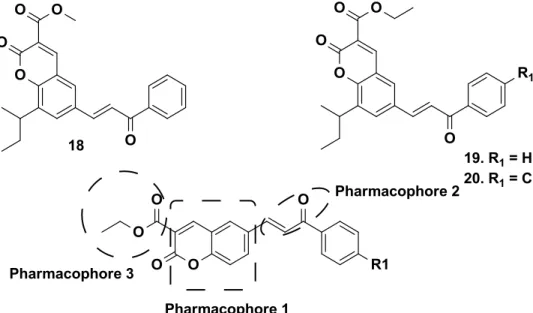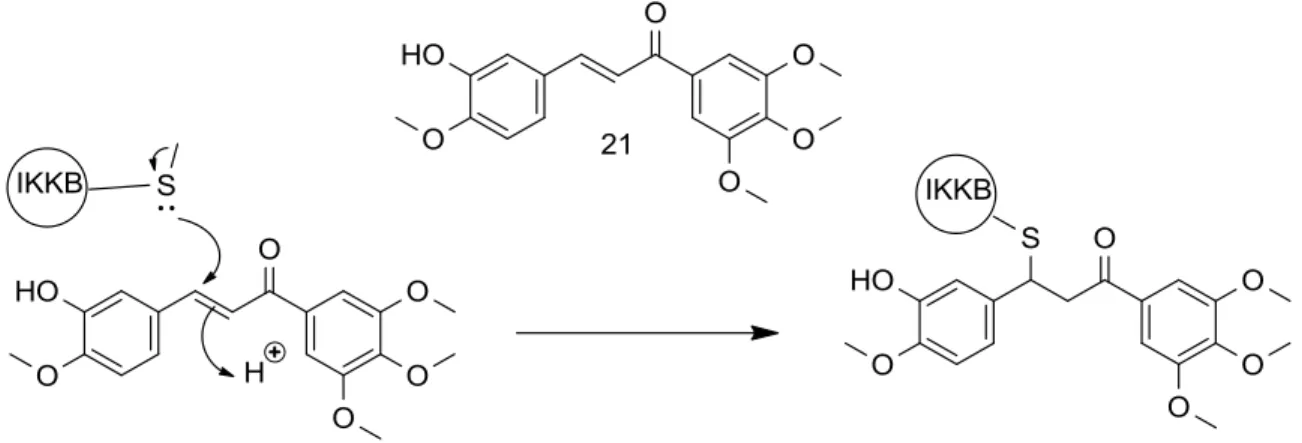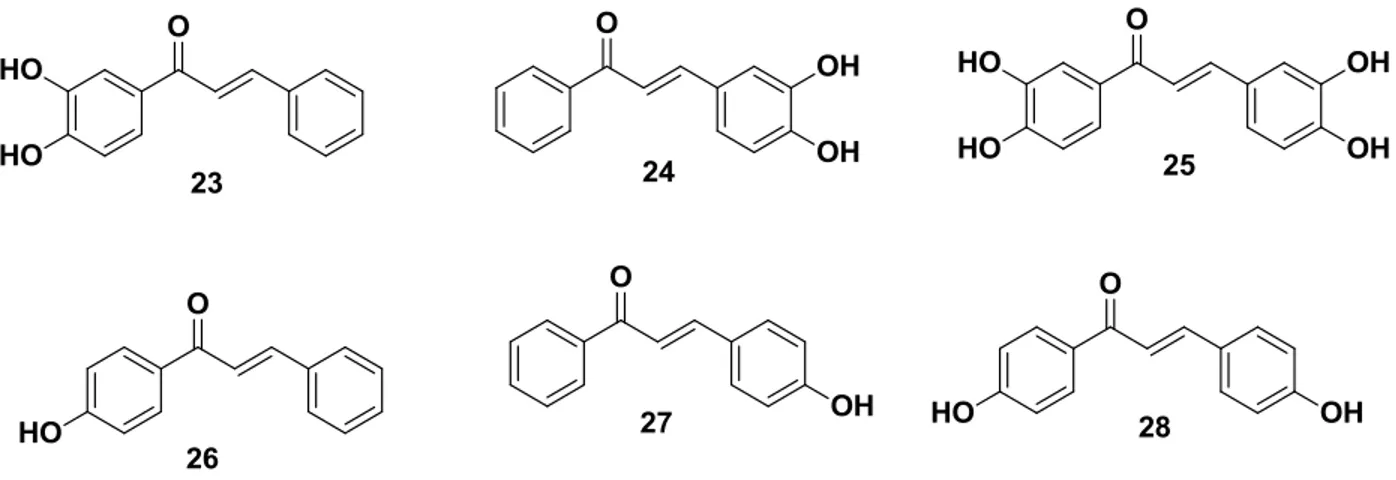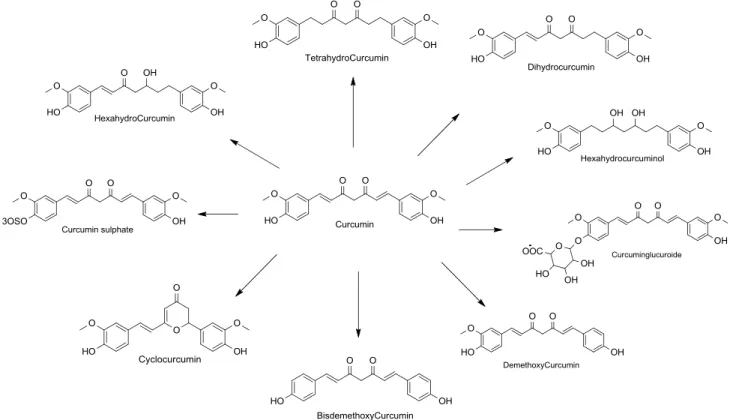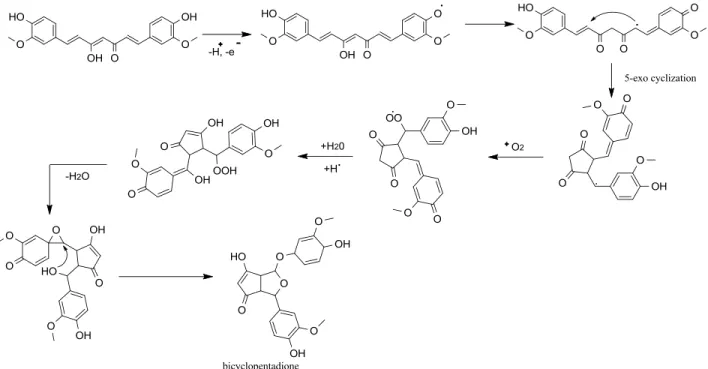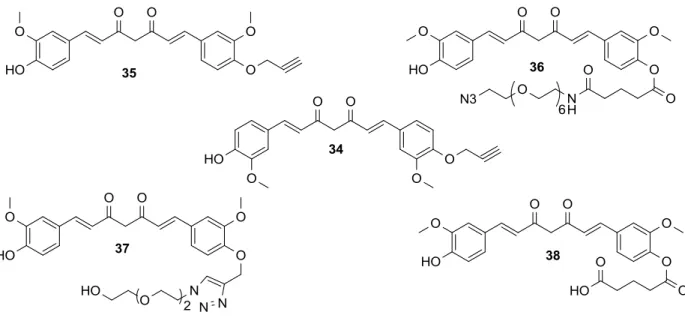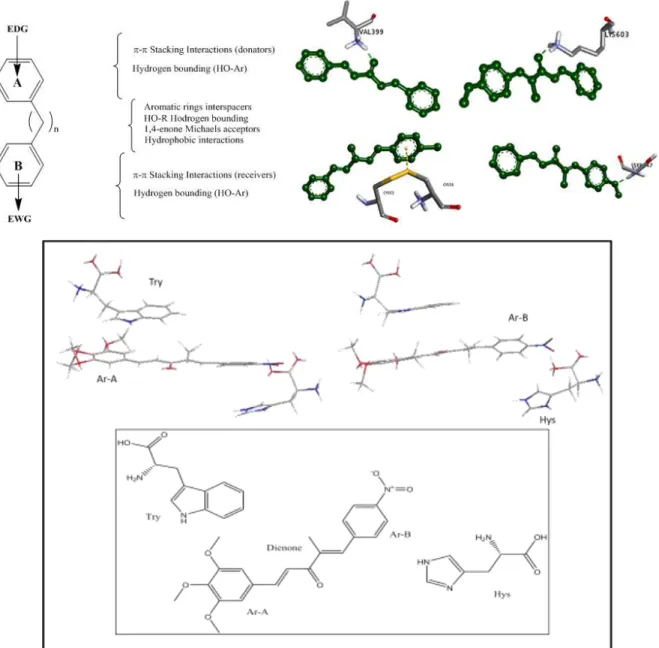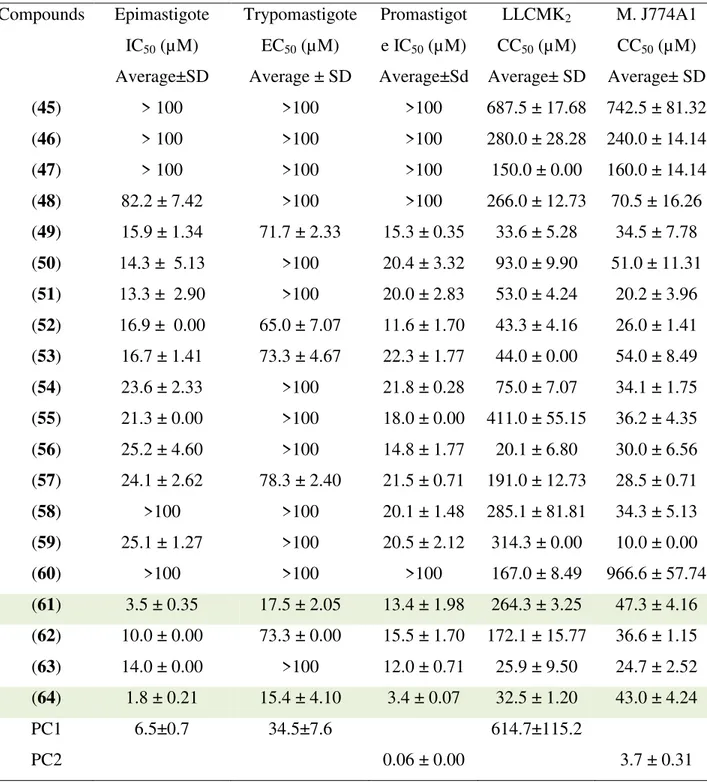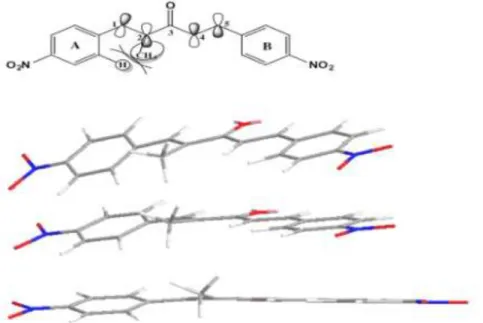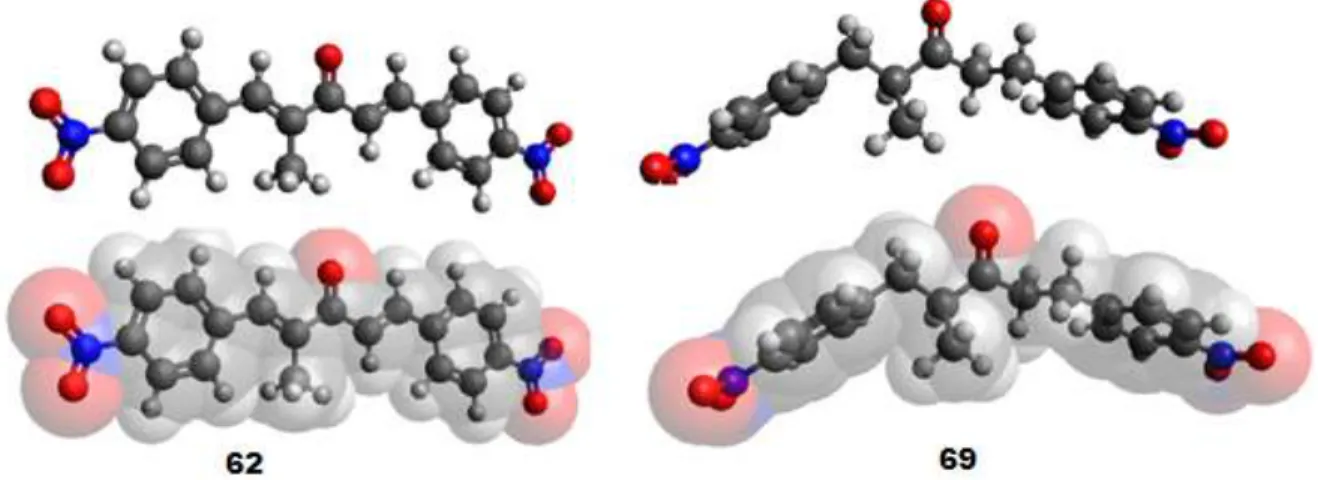UNIVERSIDADE FEDERAL DE SÃO CARLOS
CENTRO DE CIÊNCIAS EXATAS E DE TECNOLOGIA
DEPARTAMENTO DE QUÍMICA
PROGRAMA DE PÓS-GRADUAÇÃO EM QUÍMICA
“Synthesis, structural diversification, biological activities
and biotransformation of dibenzylacetones: simple
chemistry furnishing potent compounds”
Zia Ud Din
*
Thesis Submitted to the Federal University of Sao Carlos for the Degree of Doctor of Science, in Organic Chemistry
Supervisor: Prof. Dr. Edson Rodrigues Filho
* Awardee (TWAS/CNPq)
Ficha catalográfica elaborada pelo DePT da Biblioteca Comunitária UFSCar Processamento Técnico
com os dados fornecidos pelo(a) autor(a)
D583s
Din, Zia Ud
Synthesis, structural diversification, biological activities and biotransformation of dibenzylacetones : simple chemistry furnishing potent compounds / Zia Ud Din. -- São Carlos : UFSCar, 2016.
225 p.
Tese (Doutorado) -- Universidade Federal de São Carlos, 2016.
IN THE NAME OF ALLAH
THE COMPASSIONATE
THE MERCIFUL
“
“
W
W
e
e
m
m
a
a
d
d
e
e
e
e
v
v
e
e
r
r
y
y
l
l
i
i
v
v
i
i
n
n
g
g
t
t
h
h
i
i
n
n
g
g
f
f
r
r
o
o
m
m
w
w
a
a
t
t
e
e
r
r
,
,
W
W
i
i
l
l
l
l
t
t
h
h
e
e
y
y
n
n
o
o
t
t
t
t
h
h
e
e
n
n
b
b
e
e
l
l
i
i
e
e
v
v
e
e
?
?
”
”
(
(AALL--QQUURRAANN,,SSUURRAAAANNBBIIYYAAHH2211,,AAYYAAHH3300))..
AN ADORE TO
Memorandum
The research presented in this thesis has been carried out in Laboratório de Bioquímica Micromolecular de Microorganismos - LaBioMMi at the Department of Chemistry Federal University of São Carlos, São Carlos SP Brazil, between March 2012 and March 2016. This thesis presents the original work of the author unless stated elsewhere and otherwise. Additionally, none of this work has been submitted for any other degree prior to this.
Acknowledgement
All praises for Almighty ALLAH, Who is the most Omnificent, Omniscient, Omnipotent, and Omnipresent, heartily thanks for giving me the will and strength to accomplish this job.
I am showing my humble submission to the heart and soul of the world and the world hereafter; The Holy Prophet Hazrat Mohammad (Peace be upon him), whose life is an ideal pattern for us.
The work presented in this thesis was impossible without the invaluable guidance, keen interest and valuable suggestions of my ingenious and determined research supervisor Prof. Dr Edson Rodrigues Filho to whom, wish to acknowledge my indebtedness and sincere thanks. He contributes actively in the full fillment this project. The work embodied here could never be accomplished without the encouragement and precious attention.
I wish to express my thanks to who have extended their co-operation in providence of research assistance to me during the entire course of this work, prominent among them are Prof. Dr. Kleber Thiago de Oleveira whose provide me space in his lab for early synthetic work. More ever I extend my thanks to lab members for their cooperation and nice hospitality during the stay of Sao Carlos. Here I would like to specially thank to the Alef Santos and Estefanie who participetated in the course of this work. I also attribute my acknowledgment to Taicia Pacheco Fill, Marilia almeida Trapp and Livia Soman by helping in mass analysis. Diana Lopez and Ana Carolina Santos helped by providing concise information regarding biotransformation. Diana also helped by providing well established method of Sugiol isolation and other metabolites from Cupressus lusitanica. I also extend the acknowledgment to
and providing information regarding biotransformation and other lab equipments. I also thanks to new lab members Dayani, Thiers, Tayane, Isabela, Natalia for their good moments in lab. Moreover, I owe my deepest gratitude to Prof. Dr. Celso Nakamuro from Maringa and his students Danielli Biodia, Francilli, and Vanessa Calpum for contributing in the work by carrying the anti-parasitic activity.
I offer my utmost gratitude to my funding Agencies (TWAS/CNPq) who made me able to come here and supported me from beginning of the research to the end of this thesis.
The whole work was carried out, completed, and made accessible with the excellent facilities at LaBioMMi, department of chemistry Federal University of São Carlos SP Brazil. I owe my deepest gratitude to all faculty members for their cooperation, valuable suggestions, and the deepest thanks for the technical and nontechnical staff of Federal university of São Carlos.
I offer my sincere thanks for sincere company of my Pakistani friends working in USP São Carlos, UFSCar, and Embarapa; who made some memorable trips and parties during vacations to have fun and joy during this stay.
How can I forget my best friends Akbar Ali and Sajjad Ali, I have no as such wording of thanks for their sufferings and sacrifices for making my stay good here in Sao Carlos.
At last but not least, my acknowledgment will never be completed without thanking my parents especially my father mother and brothers, their moral support and encouragement.
i
Abbreviations
BA Brønsted acid
COSY Correlation spectroscopy
DMF Dimethylformamide
DMSO Dimethylsulfoxide
ee Enantiomeric excess
HB Hydrogen bonding
HSQC Heteronuclear single-quantum correlation HMBC Heteronuclear multiple bond correlation
LB Lewis base
NOE Nuclear overhauser effect NMR Nuclear magnetic resonance
DIMCARB Dimethyl ammonium dimethyle carbamate
1D One-dimensional
2D Two-dimensional
D2O Deuterium oxide
HPLC High performance liquid chromatography
IR Infrared
UV Ultra Violet
Min Minute
LC Liquid chromotography
MW Molecular weight
DFT Density functional theory
ii
IC50 Half minimal inhibitive concentration
EC50 Half minimal effective concentration
iii
List of Tables
TABLE 3.1 - Antiparasitary and citotoxicity activities of 1, 5-diaryl-3-oxo-1, 4-pentadienyl derivatives 45-64………...51
TABLE 3.2 - Antiparasitary and cytotoxicity activities of compounds 61, 64
-72………...…...61
TABLE 3.3 - Docking results of compounds 61, 64-72 docked on to
trypanothione reductase………...………64
TABLE 3.4 - Unsymmetrical diraylheptanoids analogues substitution. Compounds 75-86 are derived from 73 while 87-93 are derived from
intermediate 74………..………...70
TABLE 3.5 - Antiparasitary and citotoxicity activities of biarylalkanones
73-93………..71
TABLE 3.6 - Docking results of compounds 73-93 docked on to
Trypanothione reductase………..………77
TABLE 3.7 – Substitution variation of 2nd aryl system on compounds 97, 98,
99………...…...84
TABLE 3.8 – Anti-parasitic and cytotoxic activities of biarylalkanones
94-122………....…98
TABLE 3.9: Table of selected bases………...………...100 TABLE 3.10 - Table of selected solvents for the synthesis of mono arylidene
alkanone………...………….……….101
TABLE 3.11 - Table of catalytic quantity of DIMCARB for the synthesis of
mono arylidene alkanone………...………102
TABLE 3.12 - Synthesis of mono arylidene products using acetone and
iv
TABLE 3.13: Synthesis of Mono-arylidene derived from cyclohexanone and
aldehydes………105
TABLE 3.14: Anti-parasitic activity of mono arylidene products prepared by
DIMCARB………...………….….110
TABLE 3.15 - Synthesis of asymmetrical
bis-(arylmethylidene)-cycloalkanones………...113
TABLE 3.16 - Antiparasitary and citotoxicity activities of cyclo alkanone
73-85Benznidazole and Amphotericin B….………..……117
TABLE 3.17 - Docking scores of compounds 146-157 amphotericin B and
benzonidazole………...………..120
TABLE - 3.18 - Docking results: van der Waals contacts, hydrogen bonds and
halogen contacts between ligands 154 and TR; docking parameters for it,
amphotericin B and benznidazole……...………..………….121
v
List of figures
FIGURE 1.1- General formulas for Bisphenyl and Bisarylalkanoid………...02
FIGURE 1.2- Basic structure of chalcone………...….04
FIGURE 1.3 - Electron donating chalcone as potent active moiety……...….11
FIGURE 1.4 - Effect of substituents on activity………...……...12
FIGURE 1.5 - Compounds showing potent anti-cancer activity…………...13
FIGURE 1.6 - Mechanism of chalcone to inhibit NF-κB via covalent modification of IKKβ……….………..14
FIGURE 1.7 - Flourinated chalcone………..…….…….15
FIGURE 1.8 - Structures of hydroxylated chalcones………...…………16
FIGURE 1.9 - General structure of bisaryl pentane………...……..16
FIGURE 1.10 - Potent in vitro CQ-R and CQ-S inhibitors of the P. falciparum parasite……….22
FIGURE 1.11 - Dimmock synthesis of diaryl pentene having stilbene moiety………...23
FIGURE 1.12 - Mono and bi arylidene and its cyto-toxic comparison……...24
FIGURE 1.13 - Structures with IC50 values in µM………...…….24
FIGURE 1.14 - Nitro group on benzene significantly enhance its potential...26
FIGURE 1.15 - General structural representation of Curcuminoids………....26
FIGURE 1.16 - Curcumine, keto enol form………...……..27
FIGURE 1.17 - Natural curcumin and its metabolits………...……29
FIGURE 1.18 - Degradation products of curcumin………...……..30
FIGURE 1.19 - Synthesis of curcumin and its analogues…………...……….35
FIGURE 1.20 - Mono functional curcumin derivatives………...……36
vi
FIGURE 1.22 - Potent neuro protective compounds………...…42
FIGURE 1.23 - Interaction representation of biphenyls………...……...44
FIGURE 3.1 – Computational optimization show that ring A become out of the plane due to steric hinderance caused by CH3 group close to Ar-H on ring
A………...53 FIGURE 3.2: Planarity loses as the result of reduction of double bonds in compound 64, calculated by Avogadro 1.1.1………...………62
FIGURE 3.3 - In-silico analysis of the interaction of compounds 61 (above)
and 64 (below) with active site of 1BZL……….………65
FIGURE 3.4 - Comparison of compound 69 and 70 interactions in 2D……..65
FIGURE 2.5 - Electronic distributions for for compound 64. Semi-empirical
calculations were performed using the Gaussian software package with the semi empirical B3LYP/6-31G(d,p) method and full geometric
optimization………..66
FIGURE 3.6 – Inhibition mechanism of compounds 61 and 64………..67
FIGURE 3.7 - Planarity loses by the repulsion of alkyl group at C-2 and ring A, in case of ethyl the planarity loss is maximum compared to methyl,
calculated by Avogadro 1.1.1……….………..76
FIGURE 3.8 - Active site amino acids in protein 1BZL interaction with compound 93, the compound seem perfectly fit in the active
cavity………..……..78
FIGURE 3.9 - Active site amino acids in protein 1BZL interaction with compound 90, the compounds seem perfectly fit in the active
site………79
FIGURE 3.10 - Electronic distributions for for compound 75, 77, 87 and 88.
vii
package with the semi empirical CAM-B3LYP/6-31G(d,p) method and full
geometric optimization...……….……….81
FIGURE 3.11 - Planarity loses by the repulsion of alkyl group at C-2 and ring A, in case of ethyl the planarity loss is maximum compared to methyl, calculated by Avogadro 1.1.1……….………..94 FIGURE 3.12 - Active site amino acids in protein 1BZL interaction with compound 106, the compound seem perfectly fit in the active
cavity……….……….…………..95
FIGURE 3.13 - Active site amino acids in protein 1BZL interaction with compound 121, the compounds seem perfectly fit in the active
site…………..………..……96
FIGURE 3.14 - Synthesis of monoarylidene alkanone………...…..…...98 FIGURE 3.15 - Kinetic study of the modal reaction in CH2Cl2……...…….103
FIGURE 3.16 – Synthetic scehme of mono arylidende intermediate………108
FIGURE 3.17 - Catalytic cycle of DIMCARB for the formation of mono
arylidene intermediate……….……….………..108
FIGURE 3.18 - Best poses of ligands 127 (left) and 154 (right) in dark blue
interacting with TR structure. The good vdW contacts are represented in form of dashed-green lines, the hydrogen bonds are represented as dashed-yellow lines and the halogen bonds are represented as dashed-purple
lines………...……….122
FIGURE 8.1 - HOMO analysis of compound 3 calculated by applying
semi-empirical calculations using the Gaussian software package with the semi empirical B3LYP/6-31G(d,p) method and full energy optimization……...188 FIGURE 8.2 - Biocatalytic reduction of compounds 1 and 2 by P.brasilianum
viii
FIGURE 8.3 - Comparison of 1H NMR spectra of compound 7, 7a and 7b. Para substituted groups on ring A (NO2, NH2) influence the shift of NMR
signals of adjacent hydrogens (meta hydrogens)……….190
FIGURE 8.4 - Mass spectral analysis of 4c and 4d………...…………191
FIGURE 8.5 -Electronic distributions for for compound 4 and 6.
Semi-empirical calculations were performed using the Gaussian software package with the semi empirical B3LYP/6-31G(d,p) method and full geometric
optimization…...………...………..………194
FIGURE 8.6 - Contour maps of electron density for HUMO and LUMO of 1b
and 3b was calculated at the B3LYP/6-31G(d,p) level……….…….195 FIGURE 8.7 - Amino acid residues are shown in grey, the bound ligand in black and the flavin co factor in dark green. Hydrogen bonding interaction are
ix
List of Schemes
SCHEME 1.1- Summary of biosynthetic pathway for compounds ArCnAr´..03
SCHEME 1.2- General procedure for chalconesynthesis…………..….…….05
SCHEME1.3- Procedure for the synthesis of chalcone………...06
SCHEME 1.4 - Proposed mechanism of chalcone synthesis catalyzed by by
silica-sol gel……….07
SCHEME 1.5- Synthesis of chalcone by Suzuki Coupling………...08
SCHEME 1.6 - Synthesis of 1-(4-(9-acridinylamino)phenyl)-3(substituted)
phenylprop-2-en-1-one……….09
SCHEME 1.7 - Synthesis of biaryl pentane………...………..17 SCHEME 1.8 - Synthesis of DBA in solvent free condition…………...……18
SCHEME 1.9 - Dual activation role of LiOH during tandem cross-aldol
condensation………...19
SCHEME 1.10 - Sythesis of unsymmetrical bisaryl pentane………...……...20
SCHEME 11 - Enentioselective preparation of double aldol product……….20 SCHEME 1.11 - Study of the catalytic role of biaryl pentane in the aldol reaction between acetone and nitro-benzaldehyde…………..……….21
SCHEME 1.12 - Representation of biosynthetic pathway for curcumin…...31 SCHEME 1.13 - Synthesis of curcumin according to Pavolini………...……32
SCHEME 1.14 - Synthesis of curcumin according to Lampe………...……..33
SCHEME 1.15 - Synthesis of symmetrical curcumin anologues………33
SCHEME 1.16 - Synthesis of curcumin by Pabon et al method………..34
SCHEME 1.17 - Synthesis of Monoalkyne curcumin………...…..35
SCHEME 1.18 - Synthesis of Monofunctional Curcumin Derivatives…...…37
SCHEME 1.19 - Antioxidant mechanism of curcumin against the oxidation of
x
SCHEME 3.1 - Reaction conditions for the synthesis of compounds 45-48 and
ultimate synthesis of 49-65 from intermediate compounds
45-48……….……….48
SCHEME 3.2 - Unsymmetrical 1,5-diaryl-3-oxo-1,4-pentadienyls 61 and 64
derived metabolites. The action of parasite reduced both double
bonds………..…..55
SCHEME 3.3 - Selective reduction of different groups by selective reagent
and catalyst………...57
SCHEME 3.4 - Formation of covalent complex of 61 and 64 with
trypanothione redox system and reduction by NADPH………...…59
SCHEME 3.5 - Synthesis of intermediate compounds 73 and 74 and their
unsymmetrical diaryl analouges. Compounds 75-86 is derived from 73 while
87-93 is derived from intermediate 74……….…………69
SCHEME 3.6 - Synthesis of compounds 94-96, compound 96 having two aryl
moieties with one nitro group……….……….82
SCHEME 3.7 - Synthesis of intermediate compounds 97, 98 and 99 and their
unsymmetrical diaryl analogues. Compounds 100-106 are derived from 97
while 107-110 is derived from intermediate 98 and 111-114 from
99………..……….…………...83
SCHEME 3.8 - The synthesis of compounds with modification of alkyl groups on C-2 position, of curcuminoids………...………..85 SCHEME 3.9 - Synthesis of compounds 123 and 124 having p-triflouro and
methyl group on C-2………...……….86
SCHEME 3.10 - The synthesis of compound 125 and 126 by the reaction of
2-heptanone and p-nitro benzaldehyde in the presence of ionic liquid
DIMCARB………..…….87
xi
SCHEME 3.12 - Synthesis of unsymmetrical bis arylmethylidene
cycloalkanone………....…….109
SCHEME 3.13 - Synthesis of monoarylidene cycloadduct………...112 SCHEME 6.1- Mechanistic reduction of C=C bond by OYE………...179 SCHEME 8.1- The reduction of compounds 1-3 by synthetic catalyst and
biocatalytically by Penicillium brasilianum………..………185
SCHEME 8.2 - The reduction of compounds 4-8 by synthetic catalyst and
xii
Abstract
“
Synthesis, structural diversification, biological activities and biotransformation of dibenzylacetones: simple chemistry furnishing potentcompounds
”
The structural diversity of known compounds holding two benzene rings directly connected to each other phenyl), or separated by a carbon-chain (Bis-arylalkane), is nowadays generated intensive scientific studies across the world. Some of them are very renowned for their important biodynamic activities for human beings. For instance, the natural occurring classes of substances Stilbene (Bis-arylethene), Chalcone (Bis-arylpropenone) and Curcumin (Bis-arylheptene) have been subject of deep studies in literature due to their pharmacological activities such as antimicrobial, anti-inflammatory, anti-tumor, antioxidant and anticancer. Almost all of these compounds have in common the amino acid phenylalanine as biosynthetic precursor. In this work, we seek to give a concise overview of their structures diversity, occurrence, chemistry and the bioactivities of dibenzylacetones established. The effort to synthesize these compounds and their congeners and its modification with good pharmaceutical profile were carried. We have studied the anti-parasitic activity of all these synthesized compounds and found some potent compounds. The mechanistic study show that enzyme inside parasite reduces the C=C bonds in synthesized dibenzylacetones and leading to more potency which alter redox system of parasite, which result increase of nitrogen and oxygen species and interfere mitochondria function, which ultimately causes death of parasite. Although the literature contains only limited computational studies on these compounds, it can be predicted good and
xiii
amino acids in enzymes. We have made an effort to explain our results in the result of docking and DFT analysis.
xiv
Resumo
“
Síntese, diversidade estrutural, atividade biológica e biotransformação dodibenzalacetona: química simples fornecendo compostos potentes”xv
xvi
Summary
Abreviatures... i List of Tables... iii List of Figures ... v List of Schemes ... ix Abstract ... xii Resume.. ... xiv Part 1 ... 1
1 Introduction: Part 1………..…………...2
1.1 Chalcone……..………...…...……4
1.1.1 Synthesis of Chalcone………..…...5 1.1.2 Biological activity of Chalcone……….………..8
1.1.2.1 Anti-Malarial activity ………….………8
1.1.2.2 Anti-Inflammatory activity…………..………..10
1.1.2.3 Anti-Cancer activity……….…...……12
1.1.2.4 1.1.2.4 Anti-Oxidant……….……….15
1.2 Bisarylpentane……….…………16
1.2.1 Synthesis of Bis aryl pentane………..……..17
1.2.2 Biological activity of bisaryl pentane……….21
1.2.2.1 Anti-Parasitic activity………21
1.2.2.2 Cyto-toxic activity……….……22
1.2.2.3 Anti-Oxidant actvity………..……25
1.2.2.4 Anti-tubercular activity………..……..….25
1.3 Diarylheptanoids……….…………...……..26
1.3.1 Synthesis of Curcumin………..32
1.3.2 Biological Activity of diaryl haptanoids………...….38
xvii
1.3.2.2 Anti-Oxidant activity……….38
1.3.2.3 Anti-Cancer Activity……….40
1.3.2.4 Neuro-protective activity……….……..42
1.4 Interaction Study or In-silico study……….43
1.4.1 Hydrogen bonding interaction………..43
2 Objective –Part 1……….………….45
3 Results and discussion – Part 1...47
4.1 Synthesis………..………....48
4.2 Biological evaluation………..………….50
4.3 Transformation of compound 61 and 64 by T. cruzi………….…..54
4.4 Synthesis of compounds 65-72………...………….57
4.5 Metabolism and bioactivity study………...….58
4.6 Molecular Docking……….…….62
4.6.1 Optimization of ligands………..……62
4.6.2 In-silico interaction studies……….………63
4.6.3 Studies on molecular orbitals by computational
analysis………..……….……….65
3.7 Synthesis of compounds 73-93………67
3.8 Biological Evaluation of compounds 73-93………71 3.8.1 Antiproliferative assay……….…….71
3.9 Molecular Docking of compounds 73-93………...…….75
3.9.1 Optimization of ligands……….75
3.9.2 In-silico interaction studies……….………..76
2.9.3 Studies on molecular orbital’s by computational
analysis……….…………..…….79
xviii
3.11 Biological Evaluation of compounds 94-126……….………….89
3.11.1 Anti-proliferative assay………..…..89 3.11.2 Molecular Docking………...…...…….92
3.11.2.1 Optimization of ligands……….92
3.11.2.2 In-silicointeraction studies………..…….94
3.12 Synthesis of Monoarylidene products………...……..97 3.13 Reaction Mechanism……….………..…..106 3.14 Biological evaluation of monoarylidene products………...…..110
3.15 Synthesis of compounds 146-157……….….111 3.16 Biological Evaluation of compounds 146-157………….…….115
3.17 Molecular Docking of compounds 146-157………...117
4 Experimental –Part 1………..123
4.1 Chemistry……….………..……...….124
4.2 Synthetic detail…..………...………...……..125
4.2.1 Compound (45)………..………….…125
4.2.2 Compound (46)………...………126
4.2.3 Compound (47)…………..………...……..127
4.2.4 Compound (48)………...127
4.2.5 Compound (49)………..……….128
4.2.6 Compound (50)………...………129
4.2.7 Compound (51)………...129
4.2.8 Compound (52)……….………..130
4.2.9 Compound (53)………...………130
4.2.10 Compound (54)...131
4.2.11 Compound (55)…………...…….131
4.2.12 Compound (56)………...………132
xix
4.2.14 Compound (58)………...133
4.2.15 Compound (59)…………...……….…133
4.2.16 Compound (60)………...…………134
4.2.17 Compound (61)………….……….134
4.2.18 Compound (62)………...………..…….…135
4.2.19 Compound (63)………...……….135
4.2.20 Compound (64)………...………136
4.2.21Compound (65)………...……….136
4.2.22 Compound (66)…….……….136
4.2.23 Compound (67)……….……….…137
4.2.24 Compound (68)………..……....137
4.2.25 Compound (69)...137
4.2.26 Compound (70)...138
4.2.27 Compound (71)………..……138
4.2.28 Compound (72)………..…….139
4.2.29 Compound (73)……….…….139
4.2.30 Compound (74)………...….…..139
4.2.31Compound (75)……….…...………140
4.2.32 Compound (76)………..……….………140
4.2.33 Compound (77)…………..……….141
4.2.34 Compound (78)……..…………..………..…….141
4.2.35 Compound (79)………..……..………..…….142
4.2.36 Compound (80)………..………….………..……..142
4.2.37 Compound (81)...143
4.2.38 Compound (82)….……….………143
xx
4.2.40 Compound (84)...144
4.2.41 Compound (85)….………..………145
4.2.42 Compound (86)...145
4.2.43 Compound (87)...146
4.2.44 Compound (88)...146
4.2.45 Compound (89)...147
4.2.46 Compound (90)...147
4.2.47 Compound (91)...148
4.2.50 Compound (92)...148
4.2.51 Compound (93)...149
4.2.52 Compound (94)...149
4.2.53 Compound (95)……….……….150
4.2.54 Compound (96)………..150
4.2.55 Compound (97)………..150
4.2.56 Compound (98)……….………..151
4.2.57 Compound (99)………...………151
4.2.58 Compound (100)...151
4.2.59 Compound (101)...152
4.2.60 Compound (102)...152
4.2.61 Compound (103)...152
4.2.62 Compound (104)...153
4.2.63 Compound (105)...153
4.2.64 Compound (106)...154
4.2.65 Compound (107)...154
4.2.66 Compound (108)...154
4.2.67 Compound (109)…...……..155
xxi
4.2.69 Compound (111)...156
4.2.70 Compound (112)...156
4.2.71 Compound (113)………...…..156
4.2.72 Compound (114)………...…….157
4.2.73 Compound (115)...157
4.2.74 Compound (116)...158
4.2.75 Compound (117)...158
4.2.76 Compound (118)...158
4.2.77 Compound (119)...159
4.2.78 Compound (120)...159
4.2.79 Compound (121)...160
4.2.80 Compound (122)...160
4.2.81 Compound (123)………..………..161
4.2.82 Compound (124)……….……161
4.2.83 Compound (125)...161
4.2.84 Compound (126)……….……162
4.2.85 Compound (127)……….…...162
4.2.86 Compound (128)……...163
4.2.87 Compound (129)...163
4.2.88 Compound (130)...163
4.2.89 Compound (131)...164
4.2.90 Compound (132)………...164
4.2.91 Compound (133)...164
4.2.92 Compound (134)...165
4.2.93 Compound (135)...165
4.2.94 Compound (136)...165
xxii
4.2.96 Compound (138)………....166
4.2.97 Compound (139)...166
4.2.98 Compound (140)...167
4.2.99 Compound (141)...167
4.2.100 Compound (142)...167
4.2.101 Compound (143)...168
4.2.102 Compound (144)………...…168
4.2.103 Compound (145)...169
4.2.104 Compound (146)...169
4.2.105 Compound (147)...169
4.2.106 Compound (148)……….….…….170
4.2.107 Compound (149)……….……..…170
4.2.108 Compound (150)...171
4.2.109 Compound (151)...171
4.2.110 Compound (152)...172
4.2.111 Compound (153)...172
4.2.112 Compound (154)...173
4.2.113 Compound (155)...173
4.2.114 Compound (156)...174
4.2.115 Compound (157)...174
5 Conclusion and perspective – Part 1………...……...……175
5.1Conclusion………...……….176
5.2 Perspective………..……….176
6 Part 2………...………...………177
6.1 Abstract……….…….178
6.2 Introduction………178
xxiii
8 Results and discussion – Part 2……….………..…183
8.1 Catalytic assymetrical reduction of curcuminoids 1-8…...184
8.2 Chiral Analysis………..192
8.3 Computational DFT analysis……….……193
8.4 Molecular docking……….195
9 Experimental – Part 2………..…………..………..197
9.1 Solvents and chemicals………198 9.2 General Experimental Procedure……….……....…198
9.2.1 Preparation of Substrate (1–8)………198
9.2.2 Fungal hole cell………..…..…..199
9.2.3 Fermentation and extraction………..…….199 9.2.4 Computational study……….…200
9.2.5 In-Silicodocking analysis……….…201
10 Conclusion and Perspectives – Part 2…………...………..……..203
1
2
1. INTRODUCTION
Natural substances containing benzene ring in their molecular structures are abundant in nature. Among them, bisarylalkanoids have generated intensive scientific studies. From structural point of view, these "Bisaryl" compounds are congeners of at least three classes of important natural products stilbenes, chalcones, and cucurmins. A good series of ArCnAr´, with n varying from zero
to seven is formed (FIGURE 1.1) by grouping these compounds on the basis of carbon chain (Cn). The size of carbon chain (Cn), which acts as inter-ring spacer
separates two benzenoid rings (Ar and Ar´). Numerous studies have been conducted, by various natural product chemist, synthetic organic chemist and pharmacologists, on the inter-ring spacer bisarylalkanoids.
FIGURE 1.1- General formulas for Bisphenyl and Bisarylalkanoid.
All ArCnAr´ has a common biosynthetic origin from phenylalanine that
leads to cinnamate cascade (SCHEME 1.1) except ArC1Ar´ and ArC6Ar´ series.
ArC1Ar´ series is probably formed in nature by reductive ring opening of
xanthones, while ArC6Ar´ are not found as a natural compound instead is
3
chalcones (ArC3Ar´), gingerols and cucurmins (ArC7Ar´) seem to be
biosynthesized during anabolic phase from phenylalanine. Phenylalanine has benzene ring which oxidize generally at C-4 and C-5, and thio esterified by coenzyme-A, generating a key intermediate 4-cinnamate-SCoA (4CSCoA). In almost all plants, the intermediate 4CSCoA is converted into flavonoids. Flavonoid is one of the most abundant classes of natural product which can be enzymatically accumulated as chalcones (ArC3Ar´). Depending on the
producing organism, 4CSCoA can be further attached to polyketide chains of different sizes or other thioacyl groups to form stilbenes, gingerols and cucurmins. Compounds ArC0Ar´ (Bisphenyl) are generally lignans, and the rare
ArC4Ar´ and ArC5Ar´ appear to be formed during catabolism by
decarboxylations of lignans or lignans-intermediaries.
4
The objectives of this research are to highlight the significant and ongoing body of research on inters-ring spacer diarylalkanoids. A detailed literature about some individual classes has been focused which covers all aspects of these classes and their bioactivity. The future of inter-ring spacer diarylalkanoids produced by natural sources or synthesized is bright and iridescent due to its attractive chemistry and pharmacophoric potential. The new compounds will offer a host of exciting direction for both pure and applied research.
1.1 Chalcone
Chalcone (FIGURE 1.2) consist of two aromatic rings connected by a three
carbon α, β -unsaturated carbonyl group. Chalcones considered as the precursor
5
conjugation. Phenyl alanine is the precursor of chalcone and leads the basic skeleton of it.
1.1.1.
Synthesis of Chalcone
Chalcone can be synthesized in different synthetic methodology from
various aldehyde and ketone. A number of synthetic routes have been described
for synthesis of chalcone. The general synthesis involves Claisen Schmidt and aldol condensation (SHEME 1.2). Condensation takes place under homogeneous conditions in the presence of acid or base (IRANPOOR; KAZEMI, 1998). Traditionally, strong alkaline media including natural phosphates, Ba(OH)2, have been employed for their synthesis (SEBTI et al.,
2002). The use of several acids and bases has also been demonstrated. Ultrasound radiation and solvent free condition is also been used for pharmacological chalcone building block (LI et al., 2002).
SCHEME 1.2- General procedure for chalconesynthesis
6
LAMBA; MAKRANDI, 2008). The use of organic solvent for extraction of compound is also avoided. This methodology is highly useful for the synthesis of 2-hydroxy chalcones.
SCHEME 1.3 - Procedure for the synthesis of chalcone derivatives.
This methodology is preferred on the other conventional method due to reaction time. The reaction time is significantly less as compared to other method. Edmont V. Stoyanov et al. condensed 20-hydroxyacetophenone with
aromatic aldehydes in a well closed vessel using microwave irradiation or classical heating at 132 C°, affords a fast and simple method for the liquid-phase synthesis of 20-hydroxychalcones (STOYANOV; CHAMPAVIER; BASLY, 2002).
7
SCHEME 1.4- Proposed mechanism of chalcone synthesis catalyzed by silica-sol gel.
Ognyan Petrov et al. used thionyl chloride in ethanol as a catalytic for the
synthesis of chalcone. In this method various substituted chalcone were synthesized by aldol condensation. The HCl is produced in situ by the reaction of SOCl2 with absolute ethanol (PETROV; IVANOVA; GEROVA, 2008).
Nasser Iranpoor and Foad Kazemi used metal catalyst (Anhydrous RuC13) for
aldol condensation of aldehyde and ketone for getting chalcone analogous (IRANPOOR; KAZEMI, 1998). Regio selective self condensation reaction of some ketones and aldehydes were also described. The catalytic effect of Ru(III) is shown by performing similar reactions under thermal conditions without catalyst.
Said Eddarir et al. produced a general method for the synthesis of
8
a general synthesis of chalcones. The whole synthetic procedure is shown (SCHEME 1.5).
SCHEME 1.5 - Synthesis of chalcone by Suzuki Coupling.
1.1.2.
Biological activity of Chalcone
1.1.2.1 Anti-Malarial activity
In developing countries protozoal diseases such as malaria, amoebiosis, sleeping sickness, leishmaniasis and others are prevailing and are of great concern. The malarial diseases are still a devastating disease due to unsuitable medication, especially Plasmodium malaria, Plasmodium ovale, Plasmodium
falciparum, and Plasmodium vivax. Among all these agents, P. falciparum
9
an in vitro screen against chloroquine-susceptible (3D7) and chloroquine- resistant (Dd2) P. falciparum strains in a [3H] hypoxanthine uptake assay.
Parvesh Singh et al. synthesized acridinyl chalcone derivative by
refluxing in alcohol (TOMAR et al., 2010). In a result a series of novel chalcones bearing acridine moiety attached to the amino group in their ring A was prepared. The reaction is non catalyzed nucleophilic aromatic substitution between various 30-amino chalcone or 40-amino chalcones and 9-chloro acridine (SCHEME 1.6). Although, all the synthesized compounds inhibited full parasite growth at micro-molar concentration, Compound 1, 2 and 8,
bearing -OCH3 substituent at ring A inhibited 86%, 71% and 14.3% parasite maturation at concentrations 2 mg/mL, 0.4 mg/mL and 0.08 mg/mL, respectively. The most potent compounds did not show activity against P. yoelii
10
SCHEME 1.6 - Synthesis of 1-(4-(9-acridinylamino)phenyl)-3(substituted) phenylprop-2-en-1-one.
Compounds 1, 2 and 8 compounds showed potent activity. These new
chalcone derivatives showed much enhanced activity relative to other chalcone derivatives. Three compounds (16, 17 and 23) were further screened for in vivo
efficacy against a chloroquine-resistant rodent malaria parasite Plasmodium
yoelii (strain N-67) in Swiss mice model. In the potent compounds it is
observed that two compounds 2 and 8 having methoxy substituent’s,
significantly increases the activity.
1.1.2.2 Anti-Inflammatory activity
Many research explain the synthesis and anti-inflammatory activity of chalcone (BANDGAR et al., 2010). While various chalcones like naturally occurring, sappan chalcone (11), licochalcones (12) and butein (13) (Fig 37) are
known to exhibit potent anti-inflammatory activity (NOWAKOWSKA, 2007b; BANDGAR et al., 2010). Chalcone having cyclohexyl group 14 (FIGURE 1.3)
11
FIGURE 1.3 - Electron donating chalcone as potent active moiety.
Further studying the structure activity relationship it is observed that various substitution on chalcone also play a key role in anti-inflammatory activity. The SAR studies on Chalcone derivatives related to electron donating moiety on chalcone demonstrated that the inhibitory activity was due to the 4-hydroxy group and the possible co-planarity between the phenyl rings and the adjacent conjugated ketone (SHIGEO et al., 2001). Cheng et al. reported that
broussochalcone A (FIGURE 1.4) silent up concentration-dependent production of NO, with an IC50 value of 11.3 µM in LPS-activated macrophages. The
experimental data proposed that this compound exerted potent inhibitory effects
on NO production facilitated by its suppression of IkBα phosphorylation, IkBα
degradation, NF- kB activation and iNOS expression rather than openly on the enzymatic activity of iNOS (CHENG et al., 2001). The in-vitro experiments pointed out those compounds 15-17 to be an inhibitor of the NF-kB pathway of
12
inhibition of paw oedema, defense from weight loss and reduction of the levels of inflammatory (ROJAS et al., 2003).
FIGURE 1.4 - Effect of substituents on activity of chalcone.
1.1.2.3 Anti-Cancer activity
13
chalcone hybrids and evaluate it for their in vitro cytotoxicity against a panel of four human cancer cell lines and normal fibroblasts (NIH3T3). Among 21 compounds screened, three compounds (18-20) (FIGURE 1.5) showed IC50
range from 3.59 to 8.12 µM. The most promising compound showed around 30 fold more selectivity towards C33A (cervical carcinoma) cells over normal fibroblast NIH3T3 cells with an IC50 value of 3.59 µM. The presence of ester
moiety, especially methyl ester at position 3 and coumarin ring were believed to be crucial for the anti-cancer activity of these compounds. From this work it
is observed that pharmacophore such as α,β unsaturated system and
coumarinemoiety is crucial for activity. Therefore, a single molecule containing more than one pharmacophore, each with different mode of action could be beneficial for the treatment of cancer (SOLOMON; HU; LEE, 2009).
FIGURE 1.5 - Compounds showing potent anti-cancer activity.
14
activation is likely responsible for at least some of the cytotoxicities. Balasubramanian Srinivasan et al. explored the structure-activity relationship
(SAR) of a series of chalcone-based compounds regarding their NF-κB
inhibitory activities by using a luciferase- based in vitro NF-κB reporter assay with the objective to determine the essential functionalities on the chalcone core for NF-κB inhibition. The lead compound with low micro molar inhibitory
activity was evaluated for its inhibitory activities against kinases upstream of
NF-κB and in vitro and in vivo anticancer activities. One lead compound 21,
(FIGURE 1.6) directly inhibits the kinase activities of I kappa B kinase 2
(IKKβ) and interleukin-1 receptor-associated kinase 4 (IRAK4), potentially
responsible for its NF-κB inhibitory activities (SRINIVASAN et al., 2009).
FIGURE 1.6 - Mechanism of chalcone to inhibit NF-κB via covalent modification of IKKβ.
15
1.1.2.4 Anti-Oxidant
As we know the substitution of one group of atom in a molecule significantly modify the biological activity. Padhye et al. synthesized fluorinated chalcones and studied its anti-oxidant properties (FIGURE 1.7) (PADHYE et al., 2010). All synthesized molecules were subjected to superoxide dismutase (SOD) scavenging assay in count to their anti-cancer activity evaluation. All synthesized compounds showed good anti-oxidant activity with IC50 values ranging between 5.27 and 13.68 mM. Compound 22
with two fluorine atoms and one hydroxyl group (ortho, ring A) exhibited maximum anti-oxidant activity with IC50 value 5.27 mM, even better than the
standard molecule, ascorbic acid (IC50 ¼ 5.43 mM).
FIGURE 1.7 - Flourinated chalcone.
Yi-Ping Qian et al. synthesized Hydroxychalcones (23–28) (FIGURE
16
activity. In addition, the antioxidant activity of hydroxychalcones depends considerably on the position and number of the hydroxyl groups, the lipophilicity of the molecules and the reaction medium.
FIGURE 1.8 - Structures of hydroxylated chalcones.
1.2 Bisarylpentane
The class of biaryl in which the two moiety is seperated by 5 corbon system is called bisaryl pentane. Dibenzylideneacetones is the general examples, in which the moiety is seperated by α,β-unsaturated carbonylic system (FIGURE 1.9).
17
Due to its interesting conjugated system in the whole skeleton it shows a broad rang of pharmacological activities.
1.2.1 Synthesis of Bis aryl pentane
Various research groups have tried to synthesized it by different methods. Aher et al. synthesized a series of dibenzylideneacetones (SCHEM 1.7) from simple classical condensation of various aldehydes having different substitution with acetone (AHER et al., 2011).
SCHEME 1.7 - Synthesis of biaryl pentane.
The simple condensation is an easy method for preparation of DBA but the chances of reversible reaction increases in some cases (HATHAWAY, 1987). More study reveals that some time self-condensation is also possible and it is one of the drawback of classical aldol condensation for the preparation of biaryl pentane (NAKANO et al., 1987).
Adding more a methods developed to carry aldol reaction catalyzed by salt ammonium chloride (TEIMOURI; et al., 2009), and magnesium hydrogen sulphate (SALEHI et al., 2002). Salt is an efficient and readily available reagent and inexpensive catalyst in cross aldol condensations of different ketones with
various aromatic aldehydes to prepare the α,α'-bis(substituted benzylidene)
18
in acetic acid (MOTIUR et al., 2007), Polymer-supported sulphonic acid (NKC-9), aqueous micellar media (SHRIKHANDE; GAWANDE; JAYARAM, 2008), iodine (DAS et al., 2006), microwave synthesis with aluminium oxide and modified-phosphate.
Different catalyst is also used for the preparation of bisaryl pentane. Peyman Salehi et al. showed that aromatic aldehydes undergo crossed-aldol condensation with ketones in the presence of silica sulfuric acid under
solvent-free conditions to afford the corresponding α, β-unsaturated aldol products in
excellent yields (SCHEME 1.8) (SALEHI et al., 2004). The catalyst is extended for use in cyclic ketones. The reagent (catalyst) is reusable for several times without any decrease in the yield of the reactions.
SCHEME 1.8 - Synthesis of DBA in solvent free condition.
19
SCHEME 1.9 - Dual activation role of LiOH during tandem cross-aldol condensation between a ketone and an aldehyde.
From this work it is clear that the method is a very efficient and selective protocol for crossed-aldol condensation of ketones with aromatic aldehydes and
high yield synthesis of α,α’-bis(substituted benzylidene)cycloalkanones in the
presence of a reusable and ecologically benign catalyst. Easy and Simple work-up procedure, including washing the mixture followed by evaporation of the solvent, is another advantage of this methodology.
20
SCHEME 1.10 - Sythesis of unsymmetrical bisaryl pentane.
Guillem Valero et al. carried the enentioselective synthesis of bisaryl
pentane (VALERO; RIBÓ; MOYANO, 2014). The use of the enantiomeric catalyst (R,S)-8 allowed to obtain enantiomerically enriched (S,S)-anti-7 (78%
ee), also in a 3:1 anti/syn mixture with syn-7 (SCHEME 11). Together with chiral HPLC analysis, which suggested that product, is either formed in a non-enantioselective fashion or that it has racemised during the course of the reaction.
21
Then the catalytic role of bis aldol product were experimented in presence of appropriate solvent.
SCHEME 1.11 - Study of the catalytic role of biaryl pentane in the aldol reaction between acetone and nitro-benzaldehyde.
Firstly, as depicted in (SCHEME 1.11), it was assumed that the oxygenated functional groups of the bis(aldol) product interact with both the aldehyde and enol form of ketone. So it shows the role of bis aryl pentane as a catalyst for the synthesis of aldol products.
1.2.2 Biological activity of bisaryl pentane
Due to promising moities bisaryl pentane show various biological activity.
1.2.2.1 Anti-Parasitic activity
Braga et al. recently synthesized a series of symmetrical bisaryl pentane
22
The result of this work showed that bis aryl pentene moiety has the potential to be constructed for its action against parasite. Manohar et al. studied the
anti-malarial activity of bisarylpentane against the two strains of P. falciparum, and
found that the compounds exhibited good anti-malarial behavior in an in vitro
activity (MANOHAR et al., 2013). Twenty different compounds were tested against P. falciparum cultures and six of them were found to provide excellent
inhibition of both CQ-R and CQ-S (IC50 < 1 Μm. (FIGURE 1.10).
FIGURE 1.10 - Potent in vitro CQ-R and CQ-S inhibitors of the P. falciparum
parasite.
We synthesized a series of un-symmetrical biaryl pentane by aldol and cross aldol condensation from 2- butanone and various para substituted aromatic aldehyde. In the study four aldehyde having different electron donating and withdrawing substitution were used. All compounds were evaluated for in vitro anti-leishmanial activity.
1.2.2.2 Cyto-toxic activity
23
of human tumours in vitro, mainly towards colon cancer and leukemic cells. The activity is due to the main skeleton of compounds which was confirmed from other work of Dimmock and his colleagues. They synthesized a number of 1,3-arylidene-2-tetralones (DIMMOCK et al., 2002). The most enones were more cytotoxic than the traditional anticancer agent melphalan and some demonstrated selective toxicity towards leukemic and colon cancer cells (FIGURE 1.11). Studying the mechanism showed that the modes of action of representative compounds interfering with the biosyntheses of nucleic acids and proteins and also altering redox potentials.
FIGURE 1.11 - Dimmock synthesis of diaryl pentene having stilbene moiety
Study reveals that 1,5-diaryl-3-oxo-1,4-pentadienyl pharmacophore can be influenced by the substitution on aromatic ring. Nitro group has a greater effect on activity because it can be reduced in the tumor (DIMMOCK et al., 2005). The activity of 2-arylidenecyclohexanones and 2,6-bis(arylidene)cyclohexanone were also compared (JONATHAN et al., 2000). It was found that bis(arylidene)cyclohexanone 29 was 3 times more active than its
24
FIGURE 1.12: Mono and bi arylidene and its cyto-toxic comparison.
Literature survey confirmed that 1,5-diaryl-3-oxo-1,4-pentadienyl is pharmacophore which is considered to interact at a complementary binding site in susceptible neoplasms (DAS et al., 2007a). The presence of an acyl group has been attached to the piperidyl nitrogen atom in order to interact with an additional binding site thereby to enhance cytotoxic potencies (FIGURE 1.13). Longer substitution increases the activity significantly.
25
1.2.2.3 Anti-Oxidant actvity
Bisaryl pentane also show anti-oxidant activity. Weber et al. synthesized
and evaluate bisaryl pentane for its anti-oxidant potential (W.M. WEBER, L.A. HUNSAKER, S.F. ABCOUWER, L.M. DECK, 2005). Most of the analogues with anti-oxidant activity retain the phenolic ring substituents. It is also proposed that bisarylpentane attenuates H2O2 -induced apoptosis through direct
and indirect scavenging of ROS, leading to inhibit the mitochondria-mediated apoptotic pathway. The results suggest the potential for bisarylpentane to be used in treating diseases in which free radical and oxidative damage are involved. So this class provides significant moiety and future plane to be research more for its potential to treat to disease related to unbalance anti-oxidant.
1.2.2.4 Anti-tubercular activity
Singh et al. synthesized symmetrical bisaryl pentane analogs and studied
its anti-tubucular activity (SINGH et al., 2009). Several compounds showed moderate antitubercular activity with MIC = 12.5–1.56 μg/mL. Various 2,6 -bis(arylidene)cyclohexanones were trailed against Mycobacterium tuberculosis
H37Rv (DIMMOCK et al., 2004). The compounds inhibited the growth of the
26
FIGURE 1.14 - Nitro group on benzene significantly enhance its potential.
1.3 Diarylheptanoids
The diarylheptanoid are a class compounds consist of two aromatic
rings (aryl groups) joined by a seven carbons chain (heptane) and having various substituents (FIGURE 1.15). They can be classified into linear (curcuminoids) and cyclic diarylheptanoids (KESERÜ; NÓGRÁDI, 1995).
There natural analogs mainly extracted from plants (PER et al., 2002). There is unsaturation in the main skeleton of curcumin. This unsaturation in the main unit has an E-configuration (trans C=C bonds). The aryl rings may be symmetrically or unsymmetrically substituted; the most common natural
substituent’s are of the oxy type, such as hydroxy or methoxy elements
(BAIRWA et al., 2014).
27
Curcumin, 1,7-bis-(4-hydroxy-3-methoxy-phenyl)- hepta-1,6-diene-3,5-dione (FIGURE 1.16), is a main compound of these series is polyphenolic compound naturally present in the Curcuma longa plant, also known as tumeric. It is present in keto enol isomeric form. It was used primarily as a coloring agent and additive in food, and is the main constituents of food in many countries. Francese et al. did experiment to use curcumin as a matrix medium
in MALDI-MS (FRANCESE et al., 2013). In the result curcumin is revealed to be a versatile and multipurpose matrix. It has been applied successfully for the analysis of different pharmaceuticals and drugs, for imaging lipids in skin and lung tissues, and for the analysis of a number of compound classes in finger marks. In each experiment, the curcumin is shown to promote analyte ionization very capably as well as provide brilliant mass spectral image quality. The synthetic curcumin were preferred for the study then commercially available one. Curcumin has also long been used for its therapeutic properties in a number of medical scenarios.
FIGURE 1.16 - Curcumine, keto enol form.
28
AGGARWAL, 2008) like anti-cancer, anti-microbial, anti-viral, anti-fungal, anti-oxidant, anti-inflammatory, anti-tumor, anti-diabetic, neuro-protective activity, anti-aging and anti-platelet . It is also measured that curcumin play an important role in spinal injury recovery. Curcumin also inhibit human recombinant cytochrome P450s, show unique binding site of tubulin and telomerase inhibiting activity. In order to explain its anti-oxidant activity Sun et al. did theoretical calculation base on DFT study. It was found that H-atom abstraction from the phenolic group, not from the central CH2 group in the
heptadienone link take place.
29
FIGURE 1.17 - Natural curcumin and its metabolits.
Shen and Ji tried to evaluate the similarities between the biological activities of curcumin and its degradation products against diseases such as
Alzheimer’s disease and cancer; it was observed that the bioactive degradation
30
observed that the widely held notion that vanillin, ferulic acid, and feruloyl methane are abundant products of the non enzymatic degradation of curcumin (SCHNEIDER, O. N.; GORDON, 2012). So in the result of experiment it is determined that vanillin, ferulic acid, and feruloylmethane are not abundant degradation products of curcumin. They may very well be bioactive compounds in their own right, but should not be used to determine whether metabolites of curcumin account for its polypharmacology.
FIGURE 1.18 - Degradation products of curcumin.
O-31
methyltransferases then convert the mentioned bisdemethoxycurcumin into demethoxycurcumin and curcumin (SCHEME 1.12).
Roughley and Whiting reported feeding experiments with 14C-labelled compounds, and proposed two pathways for the formation of the curcuminoid skeleton (ROUGHLEY; WHITING, 1973) . One of the pathways involved cyclization of a polyketide chain consisting of a phenylpropanoid starter unit and five C2 units derived from malonic acid, presumably via malonyl CoA, to
give a second aromatic ring, and the other involved the condensation of two phenylpropanoids to a central carbon provided by a malonic acid molecule . They could not, however, determine experimentally which pathway represented the actual pathway of curcuminoid formation.
32
Diaryl heptanoids show potent biological activity for a series of diseases, but its oral use face problem due to its less solubilty in water. So researcher are trying to improve its solubility and bioavailability.
1.3.1 Synthesis of Curcumin
In 1937, Pavolini et al. carried out a one-step synthesis of curcumin using
2,4-pentanedione (SCHEME 1.13), vanillin and boric anhydride, but the yield was only 10% (PAVOLINI, 1937). Then Lampe in 1918 synthesized curcumin
in five steps starting from ethyl acetoacetate and carbomethoxy feruloyl chloride (SCHEME 1.14). After condensation, saponification and decarboxylation, the intermediate product was again exposed to carbomethoxy feruloyl chloride. The consequential condensation product was then cleaved under acidic conditions. Curcumin was generated after saponification and decarboxylation (V. LAMPE, 1918). Ferrari et al. synthesized symmetrical new
curcumin analogues (SCHEME 1.15) with the aim to improve the chemical stability in physiological conditions and potential anticancer activity (FERRARI et al., 2011).
33
SCHEME 1.14 - Synthesis of curcumin according to Lampe.
SCHEME 1.15 - Synthesis of symmetrical curcumin anologues.
Pabon et al. (SCHEME 1.16) reported different approach toward
34
leading to the addition of ethyl acetate. The layers were separated, and the aqueous layer was extracted once with ethyl acetate. The residue was dissolved in chloroform/methanol and subsequently cooled, after which the crystals were sucked off resulting curcumin (PABON, 2010).
SCHEME 1.16 - Synthesis of curcumin by Pabon et al method.
Soumyananda Chakraborti et al. attempted to increase the stability of
curcumin. Several analogues were synthesized in which the diketone moiety of curcumin (31) was replaced by isoxazole (compound 32) and pyrazole
(compound 33) groups (FIGURE 1.19). Isoxazole and pyrazole curcumins were
35
FIGURE 1.19 - Synthesis of curcumin and its analogues.
Luo et al. prepared monoalkyne derivative of curcumin by applying click
chemistry approach (LUO; TIKEKAR; NITIN, 2014). Modification of curcumin to its monoalkyne derivative (SCHEME 1.17) did not impact its apoptotic activity in cells. Further DSPE-PEG micelles labeled with Alexa-647 were used as a representative nanoscale carrier to improve the solubility and delivery of monoalkyne curcumin (34).
SCHEME 1.17 - Synthesis of Monoalkyne curcumin.
The approach of substitution was extended to get more substituted form (compounds 34-38) in order to get the desired solubility and bioavailability
36
FIGURE 1.20 - Mono functional curcumin derivatives.
Shi et al. converted curcumin to active monofunctional derivatives (SHI
et al., 2007). The derivatives were employed to produce a 3 + 2 azide-alkyne
“clicked” curcumin dimer and a poly(amidoamine) (PAMAM) dendrimer
37
SCHEME 1.18 - Synthesis of mono functional curcumin derivatives.
Many research data appeared to increase the solubility, stability and bioavailability and also deal with rapid metabolism of curcumin. So in order to
get the desired results curcumin is combined with BSA/ι-carrageenan
38
1.3.2 Biological Activity of diaryl haptanoids
1.3.2.1 Anti-Microbial activity
Curcumin along with other activities also show anti-microbial activity. Curcumin based metallo curcumin having amino acid has been evaluated for their anti-microbial potential (CHANDRASEKAR; PRAVIN; RAMAN, 2014). In the result it was observed that complexes exhibit better activity against bacteria and fungi than the curcumin. Curcumin-encapsulated nanoparticles were also evaluated. Curcumin exhibited immense therapeutic potential against
H. pylori infection (DE et al., 2009). Micro capsulated curcumin increase the
solubility and bioavailability as well its anti-microbial activity against various fungi and bacteria and also play its role in the preservation of food. Ascorbic acid mixed with curcumin increases its microbial activity. Conjugation of the phenolic hydroxyl group of curcumin to a sugar moiety or amino acid renders it water-soluble while enhancing its in vitro antibacterial properties. The
combination of curcumin and other antibiotic improve the activity significantly. It is also the inhibitor for Staphylococcus aureus sortase A and Streptococcus
mutans by photodynamic potential.
1.3.2.2 Anti-Oxidant activity
39
curcumin. Other study suggests that demethoxylation derivatives of curcumin are the most potent inhibitors of lipid peroxidation. Curcumin inhibit the generation of hydroxyl radicals (·OH) and iron-catalyzed lipid peroxidation. The bis-demoxycurcumin was observed to be the most potent anti-oxidant. It means hydroxyl group at para position is crucial for activity. It was also observed that methylation depresses the anti-oxidant activity. Further sterically hindered phenolic group by the introduction of two methyl groups at the ortho position increases the activity (VENKATESAN; RAO, 2000). The curcumin extract was also studied for their anti-oxidant activity. Extracts from recently dried tissue were significantly more potent than extracts from aged commercially available turmeric powder. Curcumin is also able to effectively quench singlet oxygen at very low concentration in aqueous systems (DAS; DAS, 2002).
There is different proposition about the mechanism of anti-oxidant behavior of curcumin. Gorman et al. report that curcumin radical reacts with
ascorbate ion in acetonitrile:water, and lead to the regeneration of curcumin (GORMAN et al., 1994). Other mechanism explains the binding of curcumin with lysozyme. Jovanovic et al. reported that ph 7 and below the keto form
dominates, and curcumin acts as an extraordinarily potent H-atom donor while the enolate form of the heptadienone link predominates at ph 8 and above. Masuda et al. reported that curcumin reduces about 50% of the lipid
40
SCHEME 1.19 - Antioxidant mechanism of curcumin against the oxidation of ethyl linoleate.
1.3.2.3 Anti-Cancer Activity
Curcumin is a promising anticancer agent for various cancer types. Different curcumin analogs has been synthesized and evaluated for their anti-cancer potential. Yallapu et al. evaluated therapeutic potential of novel
poly(lactic-co-glycolic acid)- curcumin nanoparticles for prostate cancer
